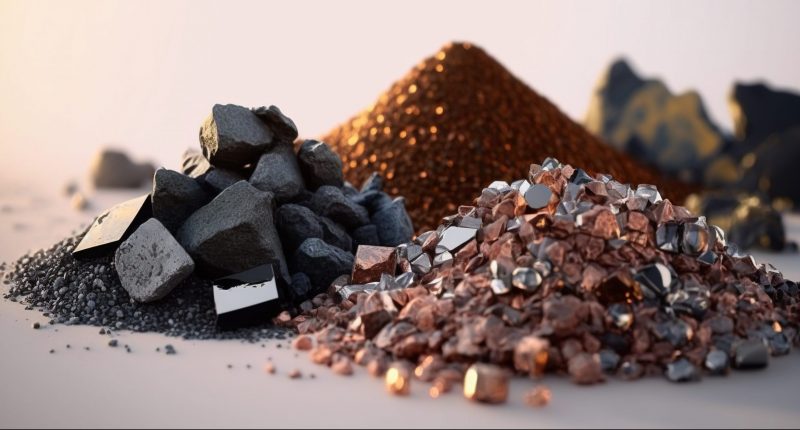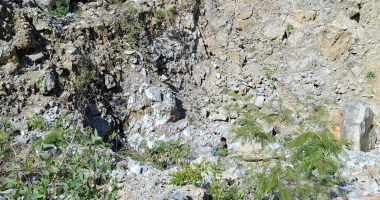The race to ensure rare earths supply chain security is heating up, especially for those materials vital for permanent magnets needed for future power technologies including wind turbines and electric vehicle motors.
Of the 17 rare earths, we’re talking here mostly about neodymium (Nd), praseodymium (Pr), dysprosium (Dy) and terbium (Tb).
They’re expensive commodities, China controls the market, and it has been closely guarding its IP around that.
China further restricted the export of technologies around making rare earth magnets late last year. It had already banned the export of extraction and separation IP.
Australia is home to some of the world’s richest deposits but finding projects of a scale for feasible mining and processing remains a challenge.
How do you make cost & profit predictions without an existing supply chain?
Junior clay-hosted rare earths explorer, Mount Ridley Mines (ASX:MRD) Technical Consultant David Crook, said determining cost and price in the industry was impossible whilst there was such supply chain dominance.
“It’s going to be hard to determine what final revenue will be – that’s why a more transparent economic supply is so important,” he said.
“What we need are committed partners prepared to align with Australia’s critical minerals strategy- I think that’s exactly the way we need to go if like-minded economies want to decouple critical minerals’ supply from China, however, who is going to step up? The first that comes to mind is the US, after that it’s Europe, which has a history of small-scale rare earths processing.
“It’ll take time and there’ll be challenges, but it’s so important if we seriously want to derisk our supply chain.”
Prime Minister Anthony Albanese and Resources Minister Madeleine King seem to be on board. They announced last October a $2 billion boost to critical minerals financing to help build supply chains with the US.
We’ll take a look at Mount Ridley’s progress shortly, but important to note is the scope also of the opportunity. Australia is lagging well behind in downstream processing in a market that’s expected to be worth more than $23 billion by 2030. That’s only six years from now.
Australia is already the world’s second-largest producer of rare earths, behind China.
Government dishes out $ to rare earths industry
Already this year the Australian Government has announced backing of projects through its Australian Critical Minerals Research and Development Hub.
This includes $13.9 million to the Australian Nuclear Science and Technology Organisation (ANSTO) for a research project into fast-tracking the discovery, extraction and processing of rare earth elements from lower-grade deposits. It’s also promised $5.2 million for CSIRO to develop IP here and knowledge that can assist downstream value chains, for rare earths and also lithium.
Minister King said the Government wanted to “de-risk investment in Australia’s critical minerals sector”.
“The Critical Minerals Facility is a cornerstone of that support, providing finance to strategically significant projects which can crowd in private investment,” she said.
“Coupled with our support for processing, we are well positioned to be a world-leading provider of critical minerals, including rare earth elements, and to support global efforts on clean energy transformation.”
Government support is vital, according to Paul Brown, the CEO of emerging producer, Hastings Technology Metals (ASX:HAS).
13 x Yangibana to meet supply deficit of 2032
Hastings reports that there would need to be 13 projects the size of its Yangibana project in the Gascoyne region of Western Australia, in order to meet the supply deficit expected in 2032.
Yangibana is about 250 kilometres northeast of Carnarvon, it covers an area of 650km2, has a 20.9 million tonne ore reserve and a predicted 17-year mine life.
Hastings is building a $210 million beneficiation plant and is targeting its first production next year.
“We have world-class mineral deposits here in Australia and need a range of initiatives and policy settings to remain competitive and attract investment to bring new projects online,” Mr Brown said.
“Australia is already home to one of the world’s biggest rare earth producers (Lynas Rare Earths (ASX:LYC) outside of China and significant potential exists to increase Australia’s rare earth supply based on our geology and world-class mining industry.
“By diversifying concentrated markets like rare earths with new sources of supply, we will ultimately have a much healthier and reliable industry to address the forecast supply gap for minerals to support global decarbonisation.”
Starting from scratch
But to explore the lifecycle stages of a rare earths project, let’s start from the beginning. And, Mount Ridley Mines is an example of a company in junior exploration.
Exploration involves geological surveys and drilling to identify potential deposits. Key goals include assessing the quality and quantity of REE deposits and understanding the geological context.
Mount Ridley Mines is working to build up kaolin clay-hosted deposits at its namesake project 90 kilometres northeast of the Port of Esperance.
It recently drilled another 155 infill holes at its priority Mia prospect in October with the results of that due this month (February). The drill pattern was designed to augment data ahead of its initial mineral resource estimate.
Mr Crook – a geologist of 40 years – is leading the operations from WA. Mount Ridley has nine exploration licenses providing a Project area of 3400km2.
It’s been finding REEs at shallow depths, with grades regularly 1000-4000 parts per million total rare earth oxide and as high as 28,000ppm.
“It is a very different style of mineralisation to Hastings, being hosted in clays and while the grade may seem low, it can be improved substantially through beneficiation, and ore will have a very different, much simpler processing route to most hard-rock deposits,” he said.
“The Mount Ridley project is displaying potential for large size, in a first-world jurisdiction, close to a deep water port at Esperance, and benefits from other existing critical infrastructure required for these types of projects.
“At the moment it’s ticking all the boxes for size and metallurgy, and Mount Ridley is determined to advance the project.
“Now that we have zeroed in on a number of priority high-grade zones, the Company’s emphasis will shift to proving the metallurgy and developing a flow sheet.”
Another junior exploration company Ark Mines (ASX:AHK) is working towards a maiden JORC Mineral Resource Estimate soon, with assay results from drilling campaigns and ongoing test work. Its Sandy Mitchell mineral sands and rare earth project is in North Queensland.
Executive Director Ben Emery said the company was working to be mine-ready by late next year or early 2026.
“We’ve got all of them, the light and the heavy rare earths, we have 15 of the 17 rare earths on the periodic table, and we haven’t been able to test for the two we don’t currently have,” he said.
“We’ve tested via gravity and we can upgrade our concentrate to a marketable product.
“Rare earths recovery plant specialist Mineral Technologies has done early work that proves that in this case, single pass recoveries bring us a very saleable rare earths concentrate. We are starting pre-feasibility work now.
“We have the advantage of dealing with one landowner who holds 770km2 with the potential to be one of the largest and lowest environmental impact mines globally,” he said.
Importantly Mr Emery said Ark could avoid costs of building its own processing facilities upfront.
“Ark is working with the goal to produce rare earths with minimal dilution for shareholders, by planning to sell into the new Queensland recovery plant built for private company Currumbin Minerals,” he said.
“That facility will make a monazite concentrate feedstock that can then be sold to operations that refine that to MREC (Mixed Rare Earth Carbonate).”
Moving into the development phase
Once a promising deposit is identified, the development phase begins. This involves detailed planning, feasibility studies, and obtaining necessary permits and funding.
As mentioned earlier, Hastings Technology Metals has completed that and is targeting first production of NdPr next year.
It’s established early infrastructure including the Kurrbili accommodation village and an airstrip.
Main plant construction begins this quarter.
CEO Paul Brown said overall construction was nearly a third of the way there, at 31 per cent complete.
“Having an operating village, airstrip and bore fields provide a strong base from where we can ramp up our workforce,” Mr Brown said.
“GR Engineering Services continues to work on the detailed engineering and design of the beneficiation plant under an early works agreement – this is now more than 80 per cent complete.
“The team continues to look at opportunities to further de-risk the project execution schedule on multiple fronts and in December we saw the arrival of the shell for the SAG mill at the port of Dampier – the first major piece of long-lead equipment for the beneficiation plant.
“With a third of critical path items by value already ordered and on schedule for delivery, project delivery risks continue to be managed and eliminated.”
Hastings is focused now on financing.
“We have also made substantial progress on the project financing front, following the receipt of multiple financing proposals from several prospective partners which include highly reputable global mining funds,” Mr Brown said.
“We’ve shortlisted parties for final due diligence – including site visits – and are focused on choosing the optimal funding package that will drive the best outcome for our shareholders.”
From Australia to Europe: Working in Estonia
While Hastings is focused on the development of the Yangibana mine and beneficiation plant, it’s also assessing the potential to capture more of the rare earth value chain through downstream processing.
“Most recently, we announced a partnership with the Estonian Government to collaborate on a joint scoping study into the potential development of a hydrometallurgical plant in Estonia,” Mr Brown said.
“This builds on our 21.15 per cent investment in Neo Performance Materials (TSE:NEO) which has an operating rare earth separation facility in Estonia, and advances our long-term vision of building a rare earth magnet supply chain for the European market.
Hastings claims its NdPr TREO ratio is 37 per cent, significantly higher than Lynas’s Mt Weld mine, which has a 23 per cent ratio, which all helps when you need to fund projects like Yangibana.
Lynas is already producing.
Lynas leads Australian production
As a $5.4 billion market cap company, Lynas Rare Earths, last quarter celebrated its first feed of material from Mt Weld into the Kalgoorlie Rare Earths Processing Facility.
Mixed rare earth carbonate (MREC) produced from the Kalgoorlie plant will be then sent to Lynas’s Malaysia plant from March where the company produces NdPr – that facility has been upgraded to be able to achieve capacity of 10,500 tonnes annually by December this year.
It has this month also completed 30 diamond drill holes and 165 reverse circulation drill holes extending exploration below and around the current Mt Weld open pit mine floor. This program was supported by its partner Japan Australia Rare Earths.
Lynas is breaking new ground in rare earths in Australia. It is just the start for an industry playing catch up with China, which also stained the industry with a dirty reputation.
Australia needs to produce magnet rare earths cleaner and greener for it to make sense.
That’s something around which Mount Ridley’s David Crook is very much aware.
“Ours will be a 21st-century mining operation with contained pits and tanks as opposed to Chinese sluicing methods – it’ll be a much more controlled process,” he said.








